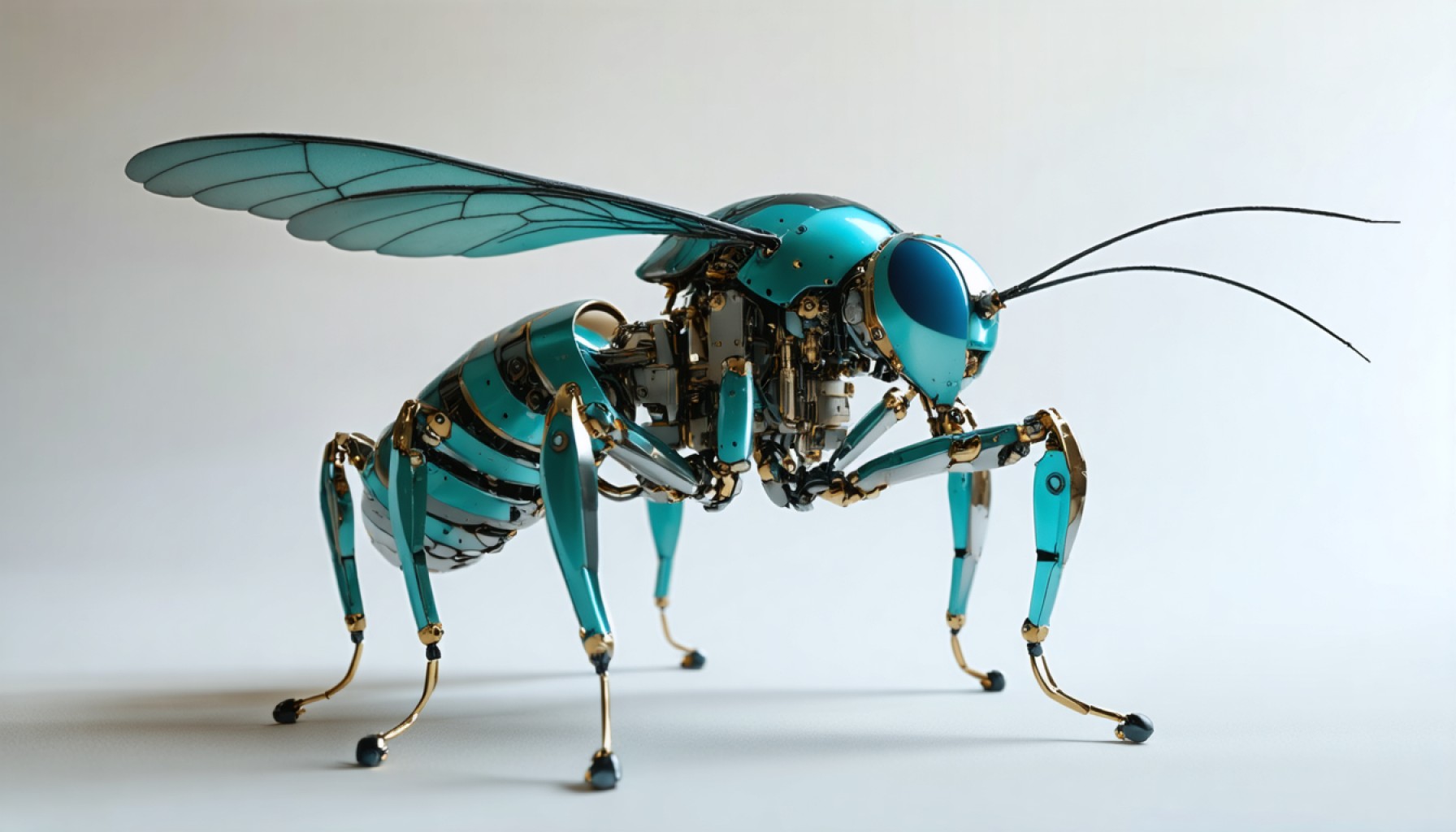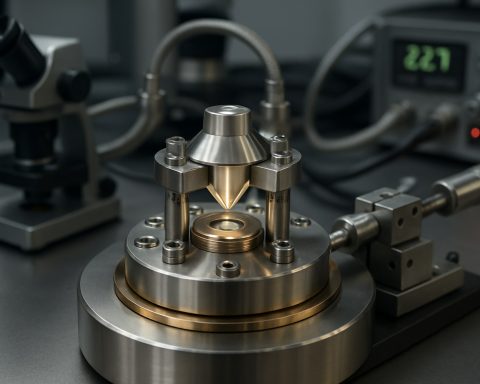- Insect-scale robots demonstrate remarkable agility and versatility, reshaping the field of miniature robotics.
- Weighing less than one gram, these robots feature a quartet of wing modules and a passive monopedal leg, powered by dielectric elastomer actuators.
- Hopping capabilities allow robots to clear obstacles up to 20 cm tall, using energy-efficient, high-frequency jumps.
- Lightweight elastic legs, made from carbon fiber or 3D-printed materials, enhance efficiency beyond 80% and withstand drops from 22 cm heights.
- The robots carry loads ten times heavier than in flight with decreased energy consumption, supporting roles in surveillance, environmental monitoring, and rescue operations.
- The innovation exemplifies how smaller, more efficient robotics could reshape future technological pathways.
Amid the ceaseless quest for innovation, a band of insect-scale robots is hopping into the future with remarkable agility and versatility. Equipped with cutting-edge technology, these lightweight marvels are reshaping our understanding of miniature robotics, offering new vistas in both functionality and efficiency.
In the world of robotics, where size and capability often stand at odds, these tiny trailblazers punch far above their weight. Weighing less than one gram, each robot flaunts a quartet of flapping-wing modules and a single, passive monopedal leg design. They owe their dynamic prowess to dielectric elastomer actuators, buzzing at a breakneck pace of 330 to 400 Hz—more than twice the speed of a hummingbird’s wings. As a result, these pint-sized powerhouses boast a lift-to-weight ratio of 1.25, achieving lateral speeds up to 36 cm/s.
Yet, the real game-changer lies in their hopping capabilities. Hurdling over obstacles that would typically impede insects, these tiny titans execute high-frequency jumps with precision. Unlike flight, which expends copious amounts of energy, hopping emerges as a more sustainable mode for these robots to navigate rugged terrains. They leap over obstacles up to 20 cm tall with rhythmic grace, utilizing a clever blend of mechanics and state-of-the-art feedback control systems.
Each hop unfolds via a meticulously planned cycle—beginning with a powered ascent followed by controlled descent, creating a near-perfect parabolic trajectory. These maneuvers are accomplished with attitude adjustments made possible through rapidly generated forces and torques, allowing the devices to achieve body rotation rates rivaling top-spinning dervishes.
Beneath the polished veneer of their aerodynamic form, innovation steeps in the lightweight elastic legs, designed either from pliable carbon fiber or a spring encased in 3D-printed armor. These nimble appendages display an astonishing efficiency rate exceeding 80%, effortlessly weathering drops from heights of up to 22 cm.
Through a compendium of meticulous experiments, these robots showcase unparalleled precision, moving with an error margin as tight as 2.1 cm at lower hop heights. When tasked with more formidable leaps, the robots adjust their ascent time, thriving on adaptability.
Apart from the sheer spectacle of their athleticism, these robots spring to prominence with their increased payload abilities during hopping. They carry loads ten times heavier than in flight while consuming significantly less energy. This remarkable feat elevates their potential for applications across surveillance, environmental monitoring, and even search and rescue operations, proving lightweight does not equate to lightweight performance.
In light of this leap in technology, it’s clear that the path forward in robotics is not just about going bigger, but also about soaring higher through ingenuity. These insect-scale robots stand as a testament to the power of innovation—showing us how the smallest steps can lead us to grand, new prospects.
Unveiling the Future: How Insect-Scale Robots Are Transforming Robotics
Introduction
Insect-scale robots herald a new era of miniature robotics, challenging the traditional notion that size limits capability. These lightweight, agile robots demonstrate a leap in technological advancement through their high-frequency hopping and efficient design. This article explores additional facts about these remarkable creations and the implications of their innovations.
Technological Features and Specifications
1. Dielectric Elastomer Actuators: Central to their functionality, these actuators operate at 330 to 400 Hz, providing the robots with unmatched speed and agility. They’re key in enabling the rapid wing-flapping that gives these robots their lift-to-weight ratio of 1.25.
2. Precision and Efficiency: With the ability to execute hops with an error margin as tight as 2.1 cm and achieve energy efficiency rates over 80%, these robots set a new benchmark in precision and resourcefulness.
3. Material Innovation: The use of materials like carbon fiber and 3D-printed composites not only reduces weight but also enhances durability, allowing these robots to withstand drops from 22 cm heights.
Real-World Use Cases
– Surveillance and Environmental Monitoring: The ability to carry payloads ten times their weight makes them ideal for deploying sensors in inaccessible or dangerous environments for data collection.
– Search and Rescue Operations: Their hopping ability enables navigation through rough terrains where traditional robots might struggle, facilitating faster survey and rescue efforts.
Market Forecasts & Industry Trends
The micro-robotics market is expected to see significant growth, particularly in sectors like environmental monitoring, agriculture, and defense. The focus on energy-efficient and multi-terrain capabilities will likely drive innovations in this space.
Pros & Cons Overview
Pros:
– Lightweight and portable.
– High precision and energy efficiency.
– Capable of carrying substantial payloads.
Cons:
– Currently limited by range and control complexity.
– Energy sources such as batteries may need innovations for longer missions.
Controversies & Limitations
While the technological prowess of insect-scale robots is undisputed, concerns arise regarding privacy (due to their surveillance capabilities) and ethical use in military applications. Regulations may need to evolve to address these issues.
Security & Sustainability
– Security: As with many emerging technologies, the security of data collected by these robots remains a concern. Innovative encryption methods must be explored to protect sensitive information.
– Sustainability: The development of biodegradable components and renewable energy sources is crucial to minimize the ecological impact of wide-scale deployment.
Actionable Recommendations
1. Stay Informed: Keep an eye on emerging trends in micro-robotics to understand potential applications in your field.
2. Leverage Capabilities: Industries like agriculture and logistics can explore prototypes to enhance efficiency in inspection and delivery processes.
3. Invest in Security: If utilizing robotic systems, invest in robust cybersecurity measures to safeguard data integrity.
Conclusion
Insect-scale robots exemplify how small innovations can lead to grand technological shifts. They not only enhance functionality within compact designs but also open up new possibilities in various sectors. By continuing to explore efficient, versatile, and sustainable designs, we can leverage these tiny powerhouses for a multitude of real-world applications.
For more insights into technological innovations, visit Robots.











